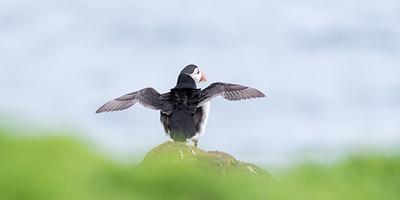
A conservation win for Scotland’s threatened seabird species
The Scottish Government have today announced that the ban on industrial sandeel fishing in Scottish waters and the English North Sea will be upheld following a challenge by the European Union [1].
The move to ban sandeel fishing in 2024 was welcomed by the Scottish Seabird Centre and conservation charities around Scotland who long called for such a ban. However, it was subsequently challenged by the EU through the Trade and Cooperation Agreement, and pushed to a legal battle in the European court earlier this year.
Harry Huyton, CEO of the Scottish Seabird Centre, said:
“Today’s announcement by the Scottish Government that the sandeel fishing ban will remain in place following the ruling in its favour is excellent news for seabirds and our precious marine environment.”
“Sandeels provide an important food source for many seabirds, including some of our most endangered species like puffin and kittiwake, which are at risk of extinction. Protecting sandeel stocks by ending unsustainable fishing is a vital step towards supporting the recovery of these fragile species.”
“The positive effects of this ban will be wide-reaching given that sandeels are preyed upon by a huge range of marine species including dolphins and porpoises, seabirds, and economically important fish including pollack, Atlantic salmon and mackerel. These tiny fish even feed marine mammals as huge as humpback and minke whales, comprising as much as half of their diet.”
“Today’s progress is good news but further action is urgently needed by the Scottish Government to tackle unsustainable fisheries, restore our marine environment and prevent extinctions, including delivering existing commitments to improve marine protected areas.”
Notes
[1] The Scottish Government response to the sandeel arbitration ruling can be found here: Marine Rural Affairs Secretary welcomes sandeel arbitration ruling - Marine
Image credits and captions:
- High-res images available to download HERE.
- Image credits Greg Macvean, Jamie McDermaid and Nicol Nicolson
- Note these images are free to use for this story only.
ENDS
For further press information:
- Jess Thompson, Marketing Manager, email jesst@seabird.org, tel: +44(0)1620 890202.
Notes for editors
- The Scottish Seabird Centre is an award-winning marine conservation and education charity whose purpose is to inspire and educate people about the Scottish marine environment and motivate people to care for it by supporting conservation projects.
- In May 2025 the Charity will celebrate its 25th anniversary of the opening of its Visitor Centre doors to the public and over the years has won multiple awards for tourism and sustainability. It has led a range of high-profile conservation and education projects including the SOS Puffin initiative in the Firth of Forth.
- Follow the Scottish Seabird Centre on Facebook/ScottishSeabirdCentre. Twitter @SeabirdCentre and Instagram @seabirdcentre
- For more information on the Scottish Seabird Centre visit www.seabird.org
Key Facts about Scotland’s marine environment
- Scotland has over 18,000km of coastline, in excess of 900 islands, 61% of the UK total sea area.
- The area of Scotland’s seas is about 6 times the land mass of Scotland.
- Scotland’s seas support an amazing diversity of wildlife with over 6,500 species recorded.
- A third of Europe’s breeding seabirds are found in Scotland.
- Seabirds are one of the world’s most threatened groups of vertebrates and one in three species are globally threatened with extinction, including populations of Atlantic Puffin (Fratercula arctica) and Black-legged Kittiwakes (Rissa tridactyla) which are enjoyed by visitors to the Firth of Forth.
- Important marine species include basking sharks, dolphins, porpoises and seals. About 35% of Europe’s harbour (or common) seal population also occur in UK waters with 83% of these found around Scotland’s coast.
- Underneath the water, Scotland supports important marine habitats such as cold-water coral, kelp forests and flame shell beds (an important blue carbon resource).
- Our oceans are important natural resource for combatting the effect of climate change. 83% of global carbon cycle is circulated through the world’s oceans and our coastal habitats account for around 50% of the total carbon sequestered in ocean sediments.
- Healthy seas, however, have huge potential to provide natural solutions to the climate emergency by locking up carbon and helping the planet to cool.
- In the last 50 years we have lost 2% of the oxygen in our oceans as a direct result of climate change, this is already having a devastating impact on our marine eco-systems and if left unchecked will be catastrophic for food security the world over.
